Muddied Waters: Perceptions and Attitudes towards Mangroves and Their Removal in New Zealand
Abstract
1. Introduction
- To interview previous consultees from resource consents for removal of areas of mangrove in the Manukau Harbour, Auckland
- To explore perceptions and attitudes towards preservation and removal of mangroves in New Zealand and specifically at four removal sites in the Manukau Harbour, Auckland
- To investigate whether demographics such as occupation, age and gender influence responses to the ratings of mangrove ecosystem services and issues facing mangroves
2. Materials and Methods
2.1. Semi-Structured Interviews
- Presence of mangroves
- Importance of mangroves
- Expansion of mangroves
- Current and future consultation process
- Mangrove management
2.1.1. Māori Participants
2.1.2. Scale-Data
2.2. Q-Sort
2.3. Statistical Analyses
2.3.1. Transcripts
2.3.2. Ecosystem Services and Issues Facing Mangroves
3. Results
3.1. Semi-Structured Interviews
3.1.1. Sustainable Balance
“I think that going in to clear mangroves solely for the reason that landowners views have changed in the last twenty to thirty years is maybe not quite so relevant anymore and we need to stop treating mangroves as the problem”.(IE4)
“Firstly, I don’t have a problem with them being removed in a sensible way”.(CO3)
“So, it’s finding a careful balance, but the fragmentation of that habitat and the effects that it has, balanced with the management feasibility, you start having to ask some serious questions whether it’s a sensible thing to do”.
“What we’ve tried to help communities really understand is that it is never a once-off removal and then nothing comes back”.(AC2)
“That concerns me a bit. It’s all very well clearing these areas of mangroves, but you are creating an awful lot of work going forward for somebody and it won’t necessarily be the people who clear them, it will be their children and grandchildren”.(IE6)
“It is not an instant one-off solution to remove mangrove, it’s like mowing a lawn. It needs continued maintenance and management, people are not looking long-term”.(K1)
3.1.2. World-View
“… this attitude has misled generations of people since the 1970′s when it (temperate mangroves) was embued with all the qualities of tropical mangals”.(CG2)
“My instinctive, but uninformed, view would have been that they would have provided a beneficial environment for wildlife, though probably through confusing them with their tropical counterpart, as seen on TV, which has quite a different ecology”.(CG3)
“If for some reason, mangrove removal was found to be a horrible thing, you stop and it will all grow back and it will grow back very quickly. It’s a reversible experiment”.(CG2)
“The experience from Pahurehure is that the predictions by so-called Council experts of the dire effects of removal have proved completely unfounded”.(CG3)
“I’ve changed my opinion of them over the years from positive to back a bit because I’ve seen encroachment of them on shorebird habitat”.(PR1)
3.1.3. Practical Management
“It’s not just a mangrove problem, it’s a whole sediment coming down from the catchment problem”.(IE2)
“I believe that they are more of a symptom of other issues that are going on within a catchment”.(IE4)
“… had been requested by local people and we actually said that from an ecological perspective, there was no benefit to clearing the mangroves”.(IE4)
“We need to look at putting the environment first before we look after ourselves”.(K5)
- water quality assessments (incoming and outgoing tides) to ascertain the role of mangroves in filtering the water
- production of a set of guidelines between regional councils to create clearance options and future predicted outcomes of removal
- keeping mangroves around stormwater outlets until contaminants are removed
- maintaining the removed area free of propagules
- identification of areas of mangrove to be preserved
- no blanket removal of mangroves
- removal of juvenile mangroves without consents being required
- leaving mangroves until natural equilibrium is reached
- designating mangrove reserves in pristine areas
- stopping further encroachment of mangrove through seedling removal
- looking at sediment management and the effects if mangrove were to be removed
- taking responsibility for management
3.1.4. Environmental Change
“They’ll get to some limit and potentially are balanced by things like sea-level increase”.(AC2)
“I’d prefer to have sediment stabilised rather than washing backwards and forwards in the ecosystem”.(CO1)
“I think there’s still a massive amount of storm water contamination that’s not being picked up and to a degree mangroves sequester that. They tie it up and stop it getting into the food chain”.(CO3)
“… they will bind sediments, so they have the potential to sequester contaminants and various other bits and pieces and for sediments in contaminated areas, that’s not such a bad thing”.(AC1)
“Aesthetics are not important, it’s the quality of the water”.
“We also advocated for the removal of the causeway in order to improve the flow of water in the inlet and potential restoration of the harbour overtime but consultation occurred too late”.(K1)
3.1.5. Values
“Generally people think that if you remove mangroves, you end up with nice white sandy beaches, which may have shown up in black and white photographs from 1952. That’s not going to happen, those days are gone, so that’s an unreasonable expectation”.(AC1)
“Reasons for removal there were recreational, so opening up navigable space for the community and the views. People want things to go back to yester year”.(AC3)
“I think it really has to be balanced with what’s best for the ecology and the motivation for removal”.(LB1)
3.2. Ecosystem Services and Issues of New Zealand’s Mangroves
3.2.1. Ecosystem Services
3.2.2. Issues Affecting New Zealand’s Mangroves
3.3. Q-Sort
4. Discussion
4.1. Polarity in Perceptions and Attitudes
“Their presence has only been detrimental”.(CG3)
“Yes, there’s no question that mangroves are beneficial, they offer so many benefits …”.(CO5)
4.2. Role of Mangroves in New Zealand and at Sites
4.3. Social Divides
4.4. Ecological Divides
4.5. Kaitiaki
4.6. Design, Recommendations and Future Directions
Author Contributions
Funding
Acknowledgments
Conflicts of Interest
Appendix A
Questions for Semi-Structured Interviews
- Do you think mangroves are part of the natural landscape in New Zealand?
- What are your opinions on mangrove presence in New Zealand (in general) and why?
- What are your opinions on mangrove presence in Pahurehure inlet 2/Mangere/Puhinui Waimahia inlets and are these different to those above? (If so, why?)
- Do you believe mangroves in New Zealand (in general) have an important role in coastal ecosystems?
- Do you think that mangroves have an important role in the coastal ecology of Pahurehure inlet 2/Mangere/Puhinui/Waimahia inlets? If so, why? If not, why?
- What coastal habitats do you value the most and why?
- Do you think mangroves have expanded, remained the same in area or retracted (at Pahurehure inlet 2/Mangere/Puhinui/Waimahia inlets)?
- Why do you think mangroves have expanded/remained the same/retracted in these areas?
- What effects do you think this has had on the ecology of these areas?
- What was the level of consultation you had for the resource consent(s)?
- What was your role (if any) in the resource consent hearing for Pahurehure Inlet 2?
- Were your opinions accurately portrayed in the hearing/written report you submitted (if applicable)?
- What needs to be improved in the future in terms of the consent process?
- What are your opinions on current mangrove management? At Pahurehure inlet 2/Mangere/Puhinui/Waimahia inlets? In New Zealand as a whole?
- Do you think anything needs to be done regarding the presence of mangroves at Pahurehure inlet 2/Mangere/Puhinui/Waimahia inlets? In New Zealand as a whole?
- What (if any) management recommendations do you have?
- What do you think the future holds for coastal environments in Pahurehure Inlet 2/Mangere/Puhinui/Waimahia inlets in terms of balancing human interest and the health of our estuaries and open water?
Appendix B
Appendix B.1. PERMANOVA Output of Pairwise Comparisons between Occupations and Ranking of Mangrove Ecosystem Services
| Unique | |||
|---|---|---|---|
| Groups | t | P (perm) | perms |
| K, IE | 1.2171 | 0.298 | 36 |
| K, CG | 2.3898 | 0.105 | 10 |
| K, AC | 1.0682 | 0.386 | 28 |
| K, CO | 0.88615 | 0.371 | 21 |
| K, PR | 1.118 | 0.632 | 3 |
| K, LB | 1.2682 | 0.332 | 3 |
| IE, CG | 2.9361 | 0.011 | 120 |
| IE, AC | 1.1864 | 0.197 | 780 |
| IE, CO | 1.5132 | 0.023 | 547 |
| IE, PR | 1.2247 | 0.208 | 36 |
| IE, LB | 2.1407 | 0.03 | 36 |
| IE, IP | 0.97551 | 0.531 | 36 |
| CG, AC | 3.1779 | 0.014 | 84 |
| CG, CO | 2.305 | 0.016 | 56 |
| CG, PR | 2.1164 | 0.104 | 10 |
| CG, LB | 1.7255 | 0.1 | 10 |
| CG, IP | 1.7203 | 0.088 | 10 |
| AC, CO | 1.5761 | 0.011 | 408 |
| AC, PR | 1.2385 | 0.241 | 28 |
| AC, LB | 2.2448 | 0.035 | 28 |
| AC, IP | 1.0184 | 0.533 | 28 |
| CO, PR | 1.2113 | 0.288 | 21 |
| CO, LB | 1.5638 | 0.151 | 21 |
| CO, IP | 0.68861 | 0.804 | 21 |
| PR, LB | 1.1151 | 0.682 | 3 |
| PR, IP | 0.65615 | 1 | 3 |
| LB, IP | 0.86178 | 0.659 | 3 |
Appendix B.2. SIMPER Output for Significant Pair Comparisons of Dissimilarity in Rating of Mangrove Ecosystem Services
| Group IE | Group LB | |||||
|---|---|---|---|---|---|---|
| Species | Av.Abund | Av.Abund | Av.Diss | Diss/SD | Contrib% | Cum.% |
| Carbon storage capacity | 1.64 | 0 | 4.04 | 6.3 | 15.03 | 15.03 |
| Medicinal properties | 0.29 | 1.5 | 2.88 | 1.87 | 10.72 | 25.75 |
| Food sources | 1.64 | 1 | 2.64 | 1.35 | 9.81 | 35.56 |
| Water quality maintenance | 1.62 | 0.71 | 2.56 | 1.27 | 9.5 | 45.07 |
| Fish habitat | 1.28 | 1 | 2.52 | 1.4 | 9.37 | 54.44 |
| Supporting offshore and nearshore fisheries | 1.37 | 0.5 | 2.34 | 1.71 | 8.7 | 63.14 |
| Nutrient retention | 1.37 | 1.5 | 1.62 | 1.23 | 6.02 | 69.15 |
| Source of wood/fuel/building materials | 0.71 | 1.37 | 1.53 | 1.07 | 5.68 | 74.83 |
| Group IE | Group CG | |||||
|---|---|---|---|---|---|---|
| Species | Av.Abund | Av.Abund | Av.Diss | Diss/SD | Contrib% | Cum.% |
| Medicinal properties | 0.29 | 1.05 | 2.43 | 1.38 | 9.47 | 9.47 |
| Cultural value | 1.38 | 0.8 | 2.25 | 1.32 | 8.75 | 18.23 |
| Sediment retention | 1.85 | 1 | 2.23 | 5.18 | 8.68 | 26.9 |
| Nutrient retention | 1.37 | 0.91 | 2.22 | 1.16 | 8.65 | 35.56 |
| Storm buffering | 1.81 | 1 | 2.13 | 5.12 | 8.29 | 43.85 |
| Wildlife habitat | 1.72 | 1 | 1.89 | 4.8 | 7.35 | 51.2 |
| Supporting offshore and nearshore fisheries | 1.37 | 1 | 1.69 | 1.69 | 6.61 | 57.81 |
| Food sources | 1.64 | 1 | 1.68 | 4.24 | 6.53 | 64.34 |
| Fish habitat | 1.28 | 1 | 1.48 | 1.55 | 5.78 | 70.12 |
| Group CG | Group AC | |||||
|---|---|---|---|---|---|---|
| Species | Av.Abund | Av.Abund | Av.Diss | Diss/SD | Contrib% | Cum.% |
| Nutrient retention | 0.91 | 1.49 | 2.29 | 1.15 | 8.41 | 8.41 |
| Cultural value | 0.8 | 1.58 | 2.23 | 1.29 | 8.21 | 16.61 |
| Wildlife habitat | 1 | 1.82 | 2.07 | 5.52 | 7.61 | 24.22 |
| Storm buffering | 1 | 1.82 | 2.06 | 6.26 | 7.58 | 31.8 |
| Medicinal properties | 1.05 | 0.8 | 1.97 | 1.24 | 7.24 | 39.04 |
| Sediment retention | 1 | 1.78 | 1.95 | 8.33 | 7.16 | 46.21 |
| Fish habitat | 1 | 1.72 | 1.78 | 3 | 6.56 | 52.76 |
| Carbon storage capacity | 1.14 | 1.82 | 1.73 | 2.68 | 6.38 | 59.14 |
| Recreational value (local) | 1 | 1.63 | 1.59 | 3.49 | 5.85 | 64.99 |
| Source of wood/fuel/building materials | 0.67 | 0.4 | 1.55 | 1.22 | 5.7 | 70.69 |
| Group IE | Group CO | |||||
|---|---|---|---|---|---|---|
| Species | Av.Abund | Av.Abund | Av.Diss | Diss/SD | Contrib% | Cum.% |
| Water quality maintenance | 1.62 | 1.2 | 2.21 | 1.16 | 11.05 | 11.05 |
| Nutrient retention | 1.37 | 1.15 | 2.17 | 1.1 | 10.83 | 21.88 |
| Carbon storage capacity | 1.64 | 1.03 | 2.04 | 1.01 | 10.2 | 32.07 |
| Supporting offshore and nearshore fisheries | 1.37 | 1.55 | 1.83 | 1.01 | 9.13 | 41.2 |
| Fish habitat | 1.28 | 1.95 | 1.65 | 1.02 | 8.24 | 49.44 |
| Cultural value | 1.38 | 1.32 | 1.5 | 0.8 | 7.5 | 56.94 |
| Source of wood/fuel/building materials | 0.71 | 1.05 | 1.46 | 1.21 | 7.3 | 64.25 |
| Flood and water flow control | 1.63 | 1.49 | 1.4 | 0.79 | 6.98 | 71.23 |
| Group CG | Group CO | |||||
|---|---|---|---|---|---|---|
| Species | Av.Abund | Av.Abund | Av.Diss | Diss/SD | Contrib% | Cum.% |
| Sediment retention | 1 | 1.6 | 2.73 | 5.08 | 7.83 | 7.83 |
| Medicinal properties | 1.05 | 0 | 2.72 | 1.3 | 7.81 | 15.64 |
| Water quality maintenance | 1.14 | 1.2 | 2.71 | 2.71 | 7.77 | 23.41 |
| Supporting offshore and nearshore fisheries | 1 | 1.55 | 2.6 | 3.94 | 7.45 | 30.85 |
| Nutrient retention | 0.91 | 1.15 | 2.6 | 1.25 | 7.45 | 38.3 |
| Fish habitat | 1 | 1.95 | 2.57 | 4.58 | 7.37 | 45.67 |
| Food sources | 1 | 1.89 | 2.44 | 3.78 | 6.99 | 52.66 |
| Wildlife habitat | 1 | 1.89 | 2.44 | 3.78 | 6.99 | 59.65 |
| Storm buffering | 1 | 1.44 | 2.31 | 3.27 | 6.63 | 66.28 |
| Carbon storage capacity | 1.14 | 1.03 | 2.29 | 1.69 | 6.57 | 72.85 |
| Group AC | Group CO | |||||
|---|---|---|---|---|---|---|
| Species | Av.Abund | Av.Abund | Av.Diss | Diss/SD | Contrib% | Cum.% |
| Carbon storage capacity | 1.82 | 1.03 | 2.15 | 1 | 10.08 | 10.08 |
| Water quality maintenance | 1.65 | 1.2 | 2.12 | 1.11 | 9.95 | 20.03 |
| Nutrient retention | 1.49 | 1.15 | 2.07 | 0.98 | 9.74 | 29.77 |
| Source of wood/fuel/building materials | 0.4 | 1.05 | 1.82 | 1.33 | 8.55 | 38.32 |
| Supporting offshore and nearshore fisheries | 1.27 | 1.55 | 1.79 | 1.11 | 8.4 | 46.72 |
| Medicinal properties | 0.8 | 0 | 1.76 | 1.3 | 8.29 | 55.02 |
| Cultural value | 1.58 | 1.32 | 1.48 | 0.91 | 6.95 | 61.97 |
| Flood and water flow control | 1.65 | 1.49 | 1.43 | 0.82 | 6.71 | 68.68 |
| Sediment retention | 1.78 | 1.6 | 1.36 | 0.75 | 6.39 | 75.06 |
| Group AC | Group LB | |||||
|---|---|---|---|---|---|---|
| Species | Av.Abund | Av.Abund | Av.Diss | Diss/SD | Contrib% | Cum.% |
| Carbon storage capacity | 1.82 | 0 | 4.31 | 7.62 | 15.61 | 15.61 |
| Water quality maintenance | 1.65 | 0.71 | 2.56 | 1.33 | 9.28 | 24.89 |
| Fish habitat | 1.72 | 1 | 2.54 | 1.22 | 9.22 | 34.11 |
| Food sources | 1.52 | 1 | 2.49 | 1.34 | 9.04 | 43.15 |
| Source of wood/fuel/building materials | 0.4 | 1.37 | 2.41 | 1.82 | 8.74 | 51.89 |
| Supporting offshore and nearshore fisheries | 1.27 | 0.5 | 2.11 | 1.67 | 7.64 | 59.53 |
| Medicinal properties | 0.8 | 1.5 | 1.9 | 1.32 | 6.89 | 66.43 |
| Nutrient retention | 1.49 | 1.5 | 1.62 | 1.32 | 5.88 | 72.31 |
Appendix B.3. PERMANOVA Output of Pairwise Comparisons between Occupations and Rating of Mangrove Issues
| Unique | |||
|---|---|---|---|
| Groups | t | P(perm) | Perms |
| IE, CG | 1.8986 | 0.019 | 120 |
| IE, AC | 1.7606 | 0.005 | 762 |
| IE, CO | 1.4945 | 0.051 | 579 |
| IE, PR | 1.1245 | 0.281 | 36 |
| IE, LB | 1.5069 | 0.105 | 36 |
| IE, IP | 1.2368 | 0.199 | 36 |
| IE, K | 0.65231 | 0.743 | 8 |
| CG, AC | 2.5778 | 0.011 | 84 |
| CG, CO | 2.1502 | 0.019 | 56 |
| CG, PR | 1.5443 | 0.108 | 10 |
| CG, LB | 1.6705 | 0.22 | 10 |
| CG, IP | 1.9428 | 0.109 | 10 |
| CG, K | 1.0458 | 0.505 | 4 |
| AC, CO | 1.4445 | 0.044 | 411 |
| AC, PR | 1.0864 | 0.348 | 28 |
| AC, LB | 1.7892 | 0.036 | 28 |
| AC, IP | 1.0484 | 0.278 | 28 |
| AC, K | 0.76864 | 0.862 | 7 |
| CO, PR | 0.99906 | 0.531 | 21 |
| CO, LB | 1.2546 | 0.24 | 21 |
| CO, IP | 0.49825 | 1 | 21 |
| CO, K | 0.69387 | 0.661 | 6 |
| PR, LB | 0.8541 | 0.635 | 3 |
| PR, IP | 0.6255 | 1 | 3 |
| PR, K | 0.30543 | 1 | 3 |
| LB, IP | 1.308 | 0.324 | 3 |
| LB, K | 0.57557 | 1 | 3 |
| IP, K | 0.54253 | 1 | 3 |
Appendix B.4. SIMPER Output of Significant Pairwise Dissimilarities in Rating of Issues Facing Mangrove by Occupation
| Group IE | Group CG | |||||
|---|---|---|---|---|---|---|
| Species | Av.Abund | Av.Abund | Av.Diss | Diss/SD | Contrib% | Cum.% |
| Nutrient pollution | 1.43 | 0.67 | 1.83 | 1.27 | 13.32 | 13.32 |
| Sea-level rise | 1.57 | 1.15 | 1.66 | 0.95 | 12.03 | 25.36 |
| Climate change (more severe droughts, floods and storms) | 1.24 | 1.67 | 1.6 | 1.31 | 11.58 | 36.94 |
| Illegal cutting/clearance | 1.84 | 1.24 | 1.43 | 1.79 | 10.35 | 47.29 |
| Chemical contamination | 1.34 | 0.94 | 1.36 | 0.89 | 9.86 | 57.15 |
| Dredging of channels | 1.47 | 1 | 1.08 | 1.31 | 7.86 | 65.02 |
| Coastal erosion | 1.4 | 1 | 0.94 | 1.91 | 6.8 | 71.82 |
| Group IE | Group AC | |||||
|---|---|---|---|---|---|---|
| Species | Av.Abund | Av.Abund | Av.Diss | Diss/SD | Contrib% | Cum.% |
| Climate change (more severe droughts, floods and storms) | 1.24 | 1.72 | 1.09 | 0.89 | 11.1 | 11.1 |
| Nutrient pollution | 1.43 | 1.62 | 1 | 1.48 | 10.2 | 21.3 |
| Dumping rubbish | 1.56 | 1.79 | 0.91 | 1.14 | 9.21 | 30.51 |
| Coastal erosion | 1.4 | 1.82 | 0.88 | 1.78 | 8.95 | 39.45 |
| Chemical contamination | 1.34 | 1.72 | 0.85 | 1.33 | 8.61 | 48.06 |
| Sea-level rise | 1.57 | 1.96 | 0.83 | 1.3 | 8.39 | 56.45 |
| Dredging of channels | 1.47 | 1.6 | 0.81 | 1.24 | 8.26 | 64.71 |
| Aesthetics (views of estuaries, the harbour, open water) | 1.52 | 1.87 | 0.73 | 0.94 | 7.4 | 72.11 |
| Group CG | Group AC | |||||
|---|---|---|---|---|---|---|
| Species | Av.Abund | Av.Abund | Av.Diss | Diss/SD | Contrib% | Cum.% |
| Nutrient pollution | 0.67 | 1.62 | 2.09 | 1.38 | 15.28 | 15.28 |
| Sea-level rise | 1.15 | 1.96 | 1.81 | 0.92 | 13.21 | 28.49 |
| Coastal erosion | 1 | 1.82 | 1.78 | 7.11 | 13 | 41.49 |
| Chemical contamination | 0.94 | 1.72 | 1.73 | 1.03 | 12.67 | 54.15 |
| Illegal cutting/clearance | 1.24 | 1.96 | 1.51 | 2 | 11.03 | 65.19 |
| Dredging of channels | 1 | 1.6 | 1.3 | 1.85 | 9.53 | 74.72 |
| Group CG | Group CO | |||||
|---|---|---|---|---|---|---|
| Species | Av.Abund | Av.Abund | Av.Diss | Diss/SD | Contrib% | Cum.% |
| Nutrient pollution | 0.67 | 1.63 | 2.27 | 1.45 | 12.24 | 12.24 |
| Chemical contamination | 0.94 | 1.43 | 2.03 | 1.15 | 10.95 | 23.18 |
| Expansion of mangroves impacting negatively on estuaries | 2 | 1.15 | 1.98 | 2.74 | 10.66 | 33.85 |
| Sea-level rise | 1.15 | 1.58 | 1.69 | 0.97 | 9.09 | 42.94 |
| Coastal erosion | 1 | 1.69 | 1.61 | 1.81 | 8.66 | 51.6 |
| Illegal cutting/clearance | 1.24 | 1.95 | 1.59 | 1.93 | 8.57 | 60.17 |
| Climate change (more severe droughts, floods and storms) | 1.67 | 1.48 | 1.54 | 0.92 | 8.28 | 68.45 |
| Dredging of channels | 1 | 1.63 | 1.46 | 1.58 | 7.87 | 76.31 |
| Group AC | Group CO | |||||
|---|---|---|---|---|---|---|
| Species | Av.Abund | Av.Abund | Av.Diss | Diss/SD | Contrib% | Cum.% |
| Expansion of mangroves impacting negatively on estuaries | 1.87 | 1.15 | 1.5 | 2.19 | 13.18 | 13.18 |
| Climate change (more severe droughts, floods and storms) | 1.72 | 1.48 | 1.24 | 0.9 | 10.83 | 24 |
| Aesthetics (views of estuaries, the harbour, open water) | 1.87 | 1.35 | 1.22 | 1.47 | 10.65 | 34.65 |
| Chemical contamination | 1.72 | 1.43 | 1.2 | 0.85 | 10.52 | 45.17 |
| Nutrient pollution | 1.62 | 1.63 | 0.94 | 1.14 | 8.26 | 53.43 |
| Increased need for access by boats | 1.77 | 1.45 | 0.85 | 1.57 | 7.43 | 60.86 |
| Sea-level rise | 1.96 | 1.58 | 0.84 | 1.15 | 7.35 | 68.2 |
| Dredging of channels | 1.6 | 1.63 | 0.81 | 1.24 | 7.09 | 75.3 |
| Group AC | Group LB | |||||
|---|---|---|---|---|---|---|
| Species | Av.Abund | Av.Abund | Av.Diss | Diss/SD | Contrib% | Cum.% |
| Sea-level rise | 1.96 | 0.87 | 2.31 | 1.17 | 24.33 | 24.33 |
| Climate change (more severe droughts, floods and storms) | 1.72 | 1 | 2.12 | 1.26 | 22.31 | 46.64 |
| Nutrient pollution | 1.62 | 1.73 | 0.79 | 1.3 | 8.29 | 54.92 |
| Dumping rubbish | 1.79 | 1.73 | 0.63 | 1.27 | 6.61 | 61.53 |
| Increased need for access by boats | 1.77 | 1.57 | 0.52 | 1.15 | 5.43 | 66.97 |
| Chemical contamination | 1.72 | 1.87 | 0.49 | 1.17 | 5.14 | 72.1 |
References
- Quisthoudt, K.; Schmitz, N.; Randin, C.F.; Dahdouh-Guebas, F.; Robert, E.M.; Koedam, N. Temperature variation among mangrove latitudinal range limits worldwide. Trees 2012, 26, 1919–1931. [Google Scholar] [CrossRef]
- Thomas, N.; Lucas, R.; Bunting, P.; Hardy, A.; Rosenqvist, A.; Simard, M. Distribution and drivers of global mangrove forest change, 1996–2010. PLoS ONE 2017, 12, e0179302. [Google Scholar] [CrossRef]
- Pocknall, D.T. Late Eocene to Early Miocene vegetation and climate history of New Zealand. J. R. Soc. N. Z. 1989, 19, 1–18. [Google Scholar] [CrossRef][Green Version]
- Green, M.; Ellis, J.; Schwarz, A.; Green, N.; Lind, D.; Bluck, B. For and Against Mangrove Control; NIWA Information Series 31; NIWA: Auckland, New Zealand, 2003; pp. 31–39. [Google Scholar]
- Harty, C. Mangrove planning and management in New Zealand and South East Australia–A reflection on approaches. Ocean Coast. Manag. 2009, 52, 278–286. [Google Scholar] [CrossRef]
- Lundquist, C.J.; Morrisey, D.J.; Gladstone-Gallagher, R.V.; Swales, A. Managing mangrove habitat expansion in New Zealand. In Mangrove Ecosystems of Asia; Springer: New York, NY, USA, 2014; pp. 415–438. ISBN 978-1-4614-8582-7. [Google Scholar]
- Crisp, P.; Daniel, L.; Tortell, P. Mangroves in New Zealand: Trees in the Tide; GP Books: Wellington, New Zealand, 1990; 69p, ISBN 0-477-01396-1. [Google Scholar]
- Morrisey, D.; Beard, C.; Morrison, M.; Craggs, R.; Lowe, M. The New Zealand mangrove: Review of the current state of knowledge. In Auckland Regional Council Technical Publication; No. 325; Auckland Regional Council: Auckland, New Zealand, 2007; Available online: http://www.nzpcn.org.nz/publications/ARC-325%20Mangrove-review.pdf (accessed on 13 December 2018).
- De Luca, S. Mangroves in NZ—Misunderstandings and Management. Available online: http://www.boffamiskell.co.nz/downloads/publications/mangroves-in-nz-misunderstandings-and-management.pdf (accessed on 13 December 2018).
- Resource Management Act 1991. Available online: http://www.legislation.govt.nz/act/public/1991/0069/latest/DLM230265.html (accessed on 11 January 2019).
- Auckland Council Unitary Plan (F2 Coastal- General Coastal Marine Zone) (2013). Available online: http://unitaryplan.aucklandcouncil.govt.nz/Images/Auckland%20Unitary%20Plan%20Operative/Chapter%20F%20Coastal/F2%20Coastal%20-%20General%20Coastal%20Marine%20Zone.pdf (accessed on 13 December 2018).
- Bell, J.; Blaney, A. Use of mangrove habitat by Threatened or At Risk birds. Report for Waikato Regional Council, 2017. Available online: https://www.waikatoregion.govt.nz/assets/WRC/Services/publications/technical-reports/2017/TR2017-23-Use-of-mangrove-habitat-by-threatened-or-at-risk-birds.pdf (accessed on 13 December 2018).
- Dencer-Brown, A.M.; Alfaro, A.C.; Milne, S.; Perrott, J. A Review on Biodiversity, Ecosystem Services, and Perceptions of New Zealand’s Mangroves: Can We Make Informed Decisions about Their Removal? Resources 2018, 7, 23. [Google Scholar] [CrossRef]
- Lindsay, P.; Norman, D.A. Human Information Processing: An Introduction to Psychology, 2nd ed.; Academic Press: New York, NY, USA, 1977; 777p. [Google Scholar]
- Pickens, J. Attitudes and Perceptions. In Organizational Behavior in Health Care; Jones & Bartlett Learning: Burlington, MA, USA, 2005; pp. 43–76. Available online: http://healthadmin.jbpub.com/borkowski/chapter3.pdf (accessed on 15 December 2018).
- Reibstein, D.J.; Lovelock, C.H.; Dobson, R. The Direction of Causality between Perceptions, Affect, Behavior: An Application to Travel Behaviour. J. Consum. Res. 1980, 6, 370–376. [Google Scholar] [CrossRef]
- Clapcott, J.; Ataria, J.; Hepburn, C.; Hikuroa, D.; Jackson, A.M.; Kirikiri, R.; Williams, E. Mātauranga Māori: Shaping marine and freshwater futures. N. Z. J. Mar. Freshw. Res. 2018, 52, 457–466. [Google Scholar] [CrossRef]
- BenDor, T.K.; Shoemaker, D.A.; Thill, J.C.; Dorning, M.A.; Meentemeyer, R.K. A mixed-methods analysis of social-ecological feedbacks between urbanization and forest persistence. Ecol. Soc. 2014, 19. [Google Scholar] [CrossRef]
- Murray, G.; D’Anna, L.; MacDonald, P. Measuring what we value: The Utility of mixed methods apporaches for incorporating values into marine social-ecological system management. Mar. Policy 2016, 73, 61–68. [Google Scholar] [CrossRef]
- Liehr, S.; Röhrig, J.; Mehring, M.; Kluge, T. How the Social-Ecological Systems Concept Can Guide Transdisciplinary Research and Implementation: Addressing Water Challenges in Central Northern Namibia. Sustainability 2017, 9, 1109. [Google Scholar] [CrossRef]
- Burke Johnson, R. Dialectical Pluralism: A Metaparadigm Whose Time Has Come. J. Mixed Methods Res. 2017, 11, 156–173. [Google Scholar] [CrossRef]
- Creamer, E. An Introduction to Fully Integrated Mixed Methods Research; SAGE Publishing: London, UK, 2018; 296p. [Google Scholar]
- Zografos, C. Rurality discourses and the role of the social enterprise in regenerating rural Scotland. J. Rural Stud. 2007, 23, 38–51. [Google Scholar] [CrossRef]
- Kufeld, C. A Q-Methodological Study Investigating the Identity of Self-Descriptions of a Group of Ex-Smokers. Dissertation Research Project, University of Luton, 2004. Available online: https://psydok.psycharchives.de/jspui/bitstream/20.500.11780/354/1/MScDissKufeld.pdf (accessed on 14 December 2018).
- McKeown, B.; Thomas, D. Quantitative Applications in the Social Sciences: Q Methodology; Sage University Press: Thosand Oaks, CA, USA, 1988. [Google Scholar] [CrossRef]
- Ho, G.W.K. Examining Perceptions and Atittudes: A Review of Likert-Type Scales Versus Q-Methodology. West. J. Nurs. Res. 2016, 39, 674–689. [Google Scholar] [CrossRef]
- Menold, N.; Bogner, K. Design of Rating Scales in Questionnaires; GESIS Survey Guidelines; GESIS – Leibniz Institute for the Social Sciences: Manheim, Germany, 2016; Available online: https://www.gesis.org/fileadmin/upload/SDMwiki/MenoldBogner_Design_of_Rating_Scales_in_Questionnaires.pdf (accessed on 13 December 2018).
- Burns, N.; Grove, S.K. The Practice of Nursing Research Conduct, Critique, & Utilization; W.B. Saunders and Co.: Philadelphia, PA, USA, 1997. [Google Scholar]
- Naresh, K.M. Questionnaire Design and Scale Development. 2006. Available online: https://www.researchgate.net/ profile/Naresh_Malhotra/publication/266864633_Questionnaire_design_and_scale_development/ links/566708fe08ae34c89a0220f9/Questionnaire-design-and-scale-development.pdf (accessed on 11 January 2019).
- Brown, S.R. A primer on Q-methodology. Operant. Subj. 1993, 16, 91–138. [Google Scholar]
- Schmolk, P. The Qmethod Page. Available online: http://schmolck.org/qmethod/ (accessed on 18 June 2018).
- Herrington, N.; Coogan, J. Q Methodology: An Overview. Res. Second. Teach. Educ. 2011, 1, 24–28. [Google Scholar]
- Yang, Y.; Bliss, L.B. A Q factor analysis of college undergraduate students’ study behaviours. Educ. Res. Eval. Int. J. Theory Pract. 2014, 20, 433–453. [Google Scholar] [CrossRef]
- Braun, V.; Clarke, V. Using thematic analysis in psychology. Qual Res Psychol. 2006, 3, 77–101. [Google Scholar] [CrossRef]
- Thomas, D.R. A general inductive approach for analyzing qualitative evaluation data. Am. J. Eval. 2006, 27, 237–246. [Google Scholar] [CrossRef]
- Nowell, L.S.; Norris, J.M.; White, D.E.; Moules, N.J. Thematic Analysis: Striving to Meet the Trustworthiness Criteria. Int. J. Qual. Methods 2017, 16, 1–13. [Google Scholar] [CrossRef]
- QSR International. Available online: http://help-nv11.qsrinternational.com/desktop/welcome/welcome.htm (accessed on 3 April 2018).
- Clarke, K.R.; Ainsworth, M. A method of linking multivariate community structure to environmental variables. Mar. Ecol. Prog. Ser. 1993, 92, 205–219. [Google Scholar] [CrossRef]
- Anderson, M.J. Permutational Multivariate Analysis of Variance (PERMANOVA), 3rd ed.; John Wiley & Sons, Ltd.: Chichester, UK, 2014. [Google Scholar] [CrossRef]
- Anderson, M.J.; Gorley, R.N.; Clarke, K.R. PERMANOVA+ for PRIMER: Guide to Software and Statistical Methods; PRIMER-E: Plymouth, UK, 2008. [Google Scholar]
- Morrisey, D.J.; Swales, A.; Dittmann, S.; Morrison, M.A.; Lovelock, C.E.; Beard, C.M. The ecology and management of temperate mangroves. In Oceanography and Marine Biology: An Annual Review; Gibson, R.N., Ed.; CRC Press: Boca Raton, FL, USA, 2010; Volume 48, pp. 43–160. [Google Scholar]
- Bulmer, R.H.; Schwendenmann, L.; Lundquist, C.J. Carbon and nitrogen stocks and below-ground allometry in temperate mangroves. Front. Mar. Sci. 2016, 3, 150. [Google Scholar] [CrossRef]
- Gritcan, I.; Duxbury, M.; Leuzinger, S.; Alfaro, A. Leaf Stable Isotope and Nutrient Status of Temperate Mangroves as Ecological Indicators to Assess Anthropogenic Activity and Recovery from Eutrophication. Front. Plant Sci. 2017, 7, 1922. [Google Scholar] [CrossRef]
- Lundquist, C.J.; Hailes, S.F.; Carter, K.R.; Burgess, T.C. Ecological Status of Mangrove Removal Sites in the Auckland Region. Prepared by the National Institute of Water and Atmospheric Research for Auckland Council. Auckland Council Technical Report, 2014a, TR2014/033. Available online: http://temp.aucklandcouncil.govt.nz/SiteCollectionDocuments/aboutcouncil/planspoliciespublications/technicalpublications/tr2014033ecologicalstatusofmangroveremovalsitesintheaklregion.pdf (accessed on 18 December 2018).
- Murray, C. An Assessment of Cost-Benefit Analysis Approaches to Mangrove Management; Auckland Council Technical Report, 2013/006; Auckland Council: Auckland, New Zealand, 2013; ISBN 978-1-927216-31-6. Available online: http://temp.aucklandcouncil.govt.nz/EN/planspoliciesprojects/reports/technicalpublications/Documents/TR2013006anassessmentofcostbenefitanalysisapproachestomangrovemanagement.pdf (accessed on 18 December 2018).
- Pendleton, L.; Donato, D.C.; Murray, B.C.; Crooks, S.; Jenkins, W.A.; Sifleet, S.; Megonigal, P. Estimating global “blue carbon” emissions from conversion and degradation of vegetated coastal ecosystems. PLoS ONE 2012, 7, e43542. [Google Scholar] [CrossRef] [PubMed]
- Alongi, D.M. Carbon cycling and storage in mangrove forests. Annu. Rev. Mar. Sci. 2014, 6, 195–219. [Google Scholar] [CrossRef]
- Bulmer, R.H.; Schwendenmann, L.; Lundquist, C.J. Allometric models for estimating aboveground biomass, carbon and nitrogen stocks in temperate Avicennia marina forests. Wetlands 2016, 36, 841–848. [Google Scholar] [CrossRef]
- Bandaranayake, W.M. Traditional and medicinal uses of mangroves. Mangrov Salt Marshes 1998, 2, 133–148. [Google Scholar] [CrossRef]
- Küchler, A.W. The Mangrove in New Zealand. N. Z. Geogr. 1972, 28, 113–129. [Google Scholar] [CrossRef]
- Dingwall, P.R. Overcoming problems in the management of New Zealand mangrove forests. In Physiology and Management of Mangroves; Teas, H.G., Ed.; Dr. W. Junk Publishers: The Hague, The Netherlands, 1984; pp. 97–106. [Google Scholar]
- Marshall, M.N. Sampling for qualitative research. Fam. Pract. 1996, 13, 522–525. [Google Scholar] [CrossRef] [PubMed]
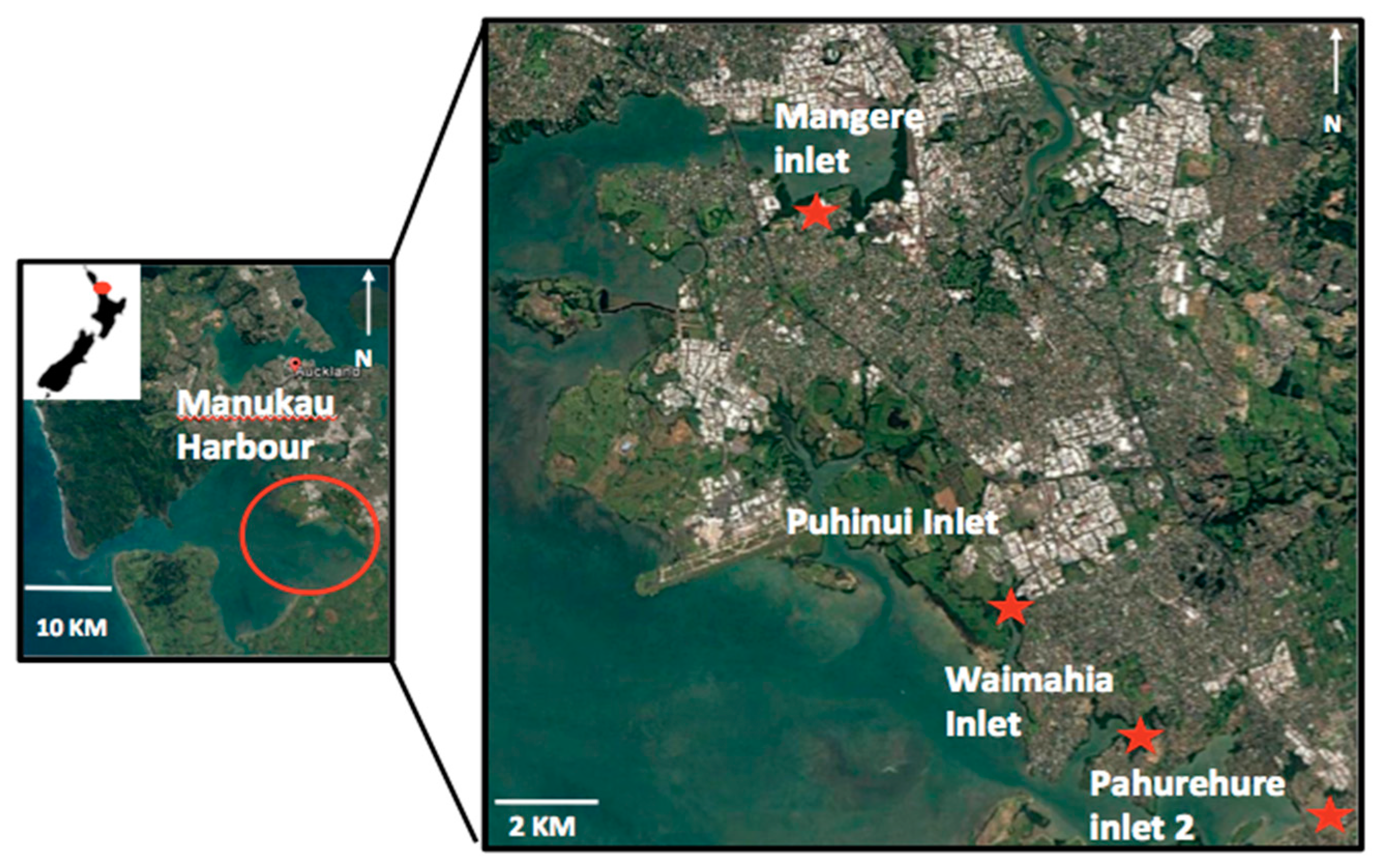
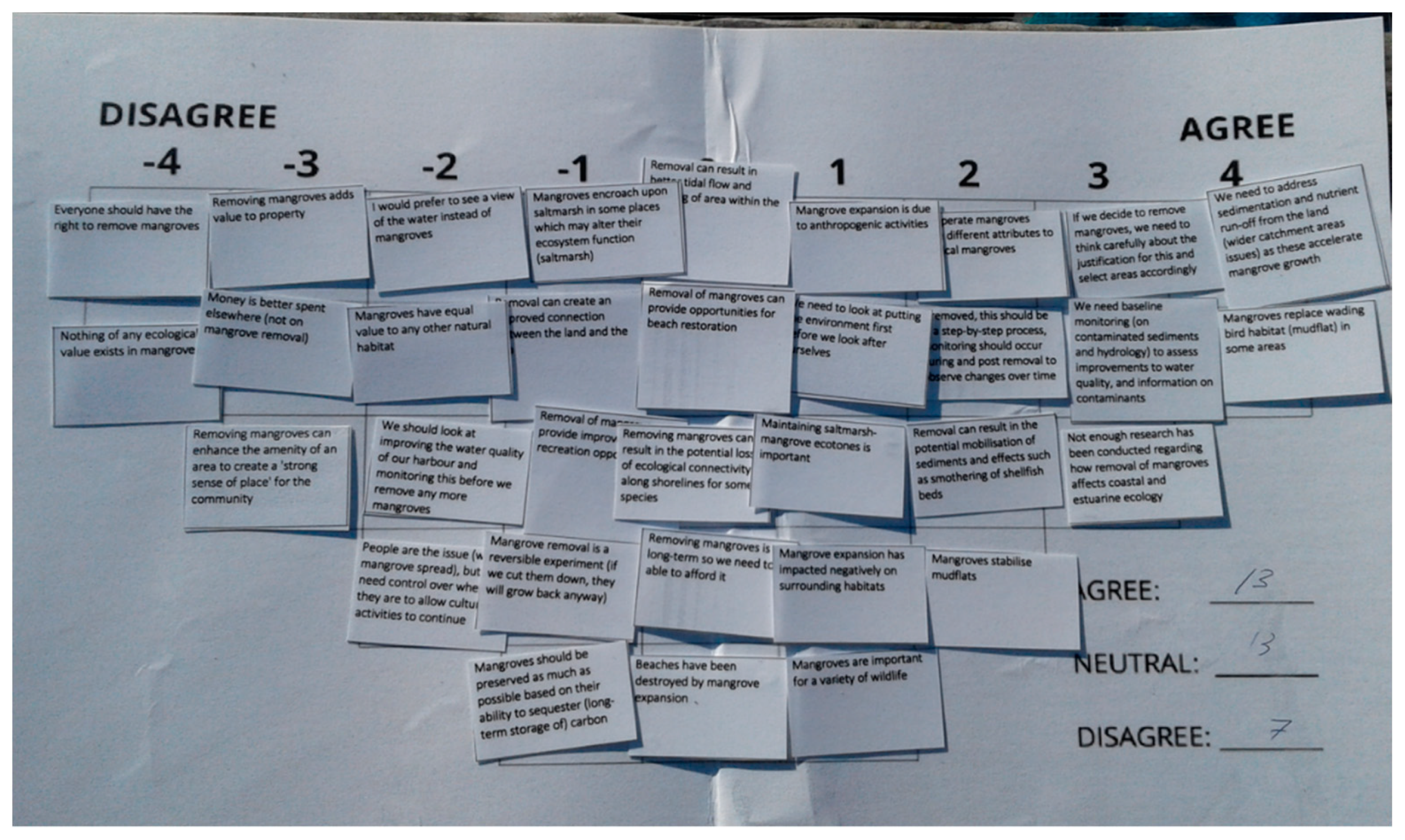
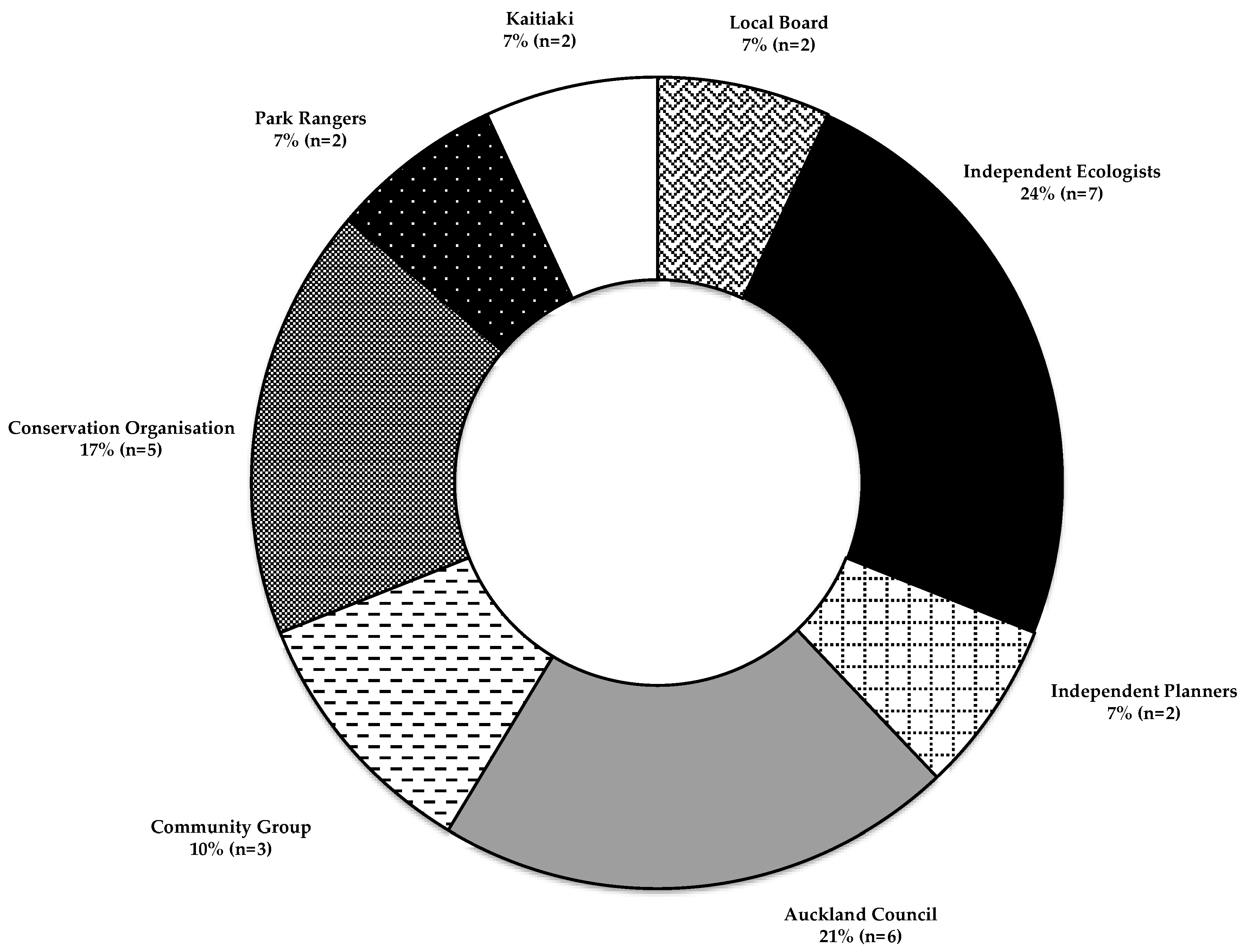
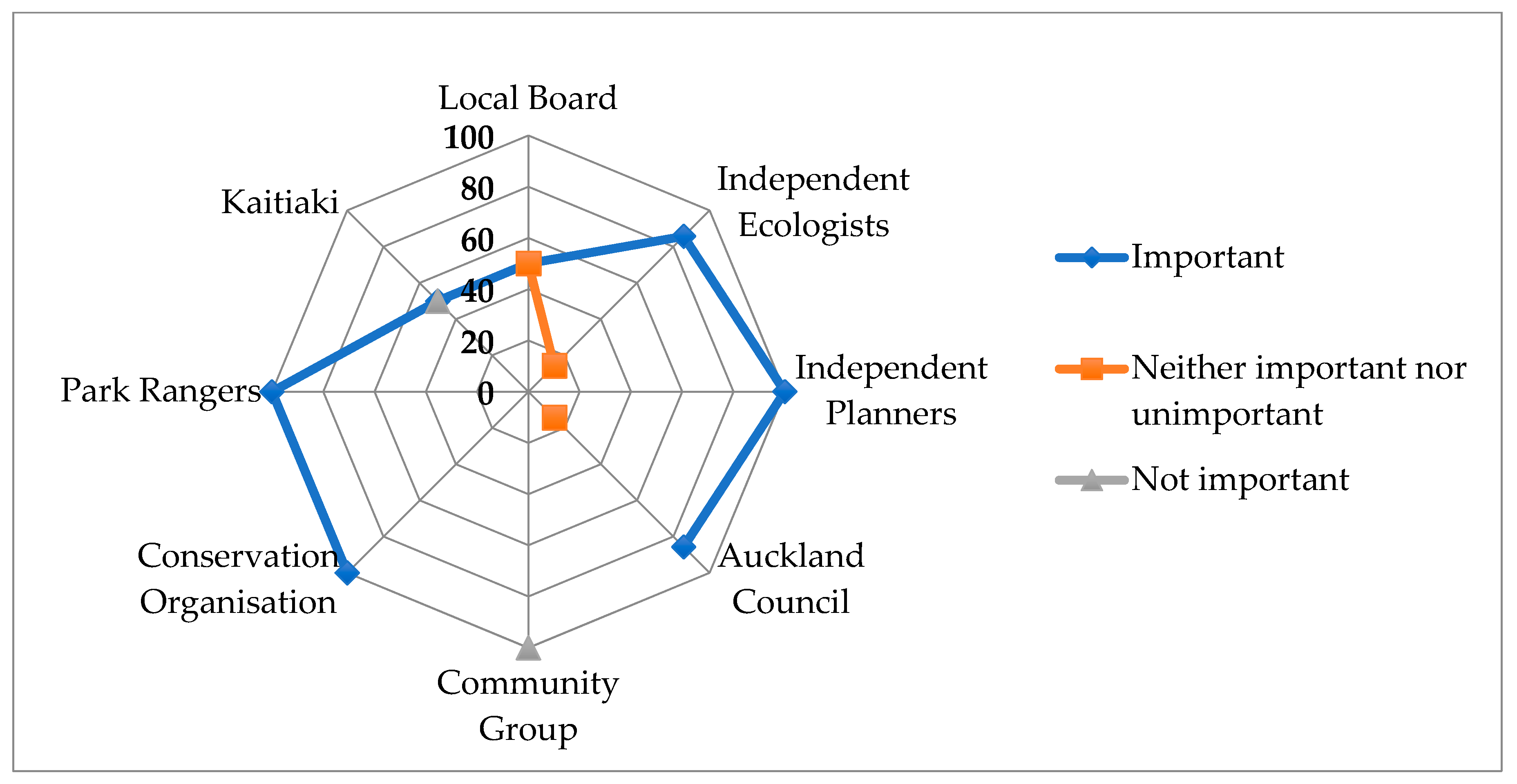
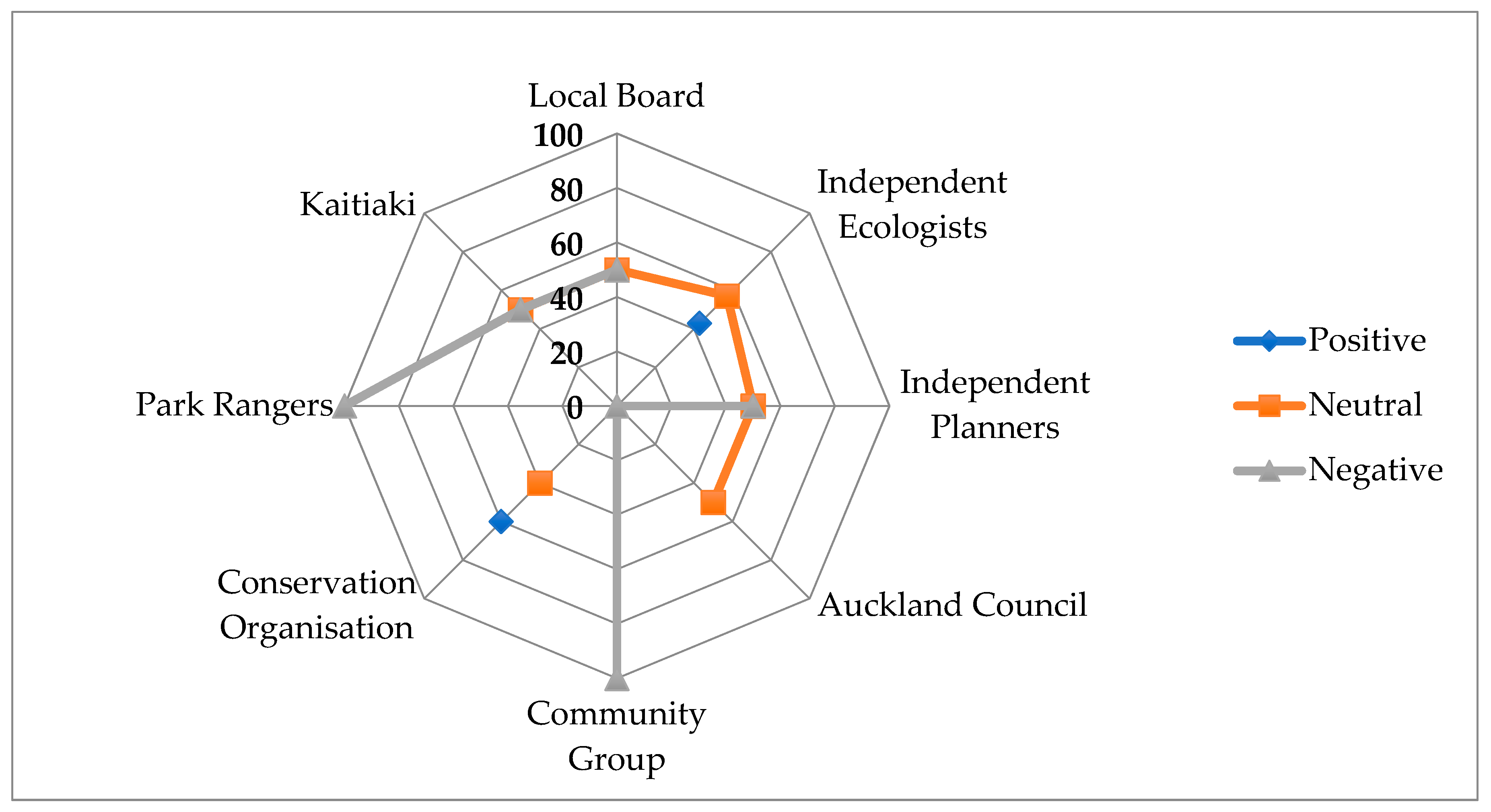
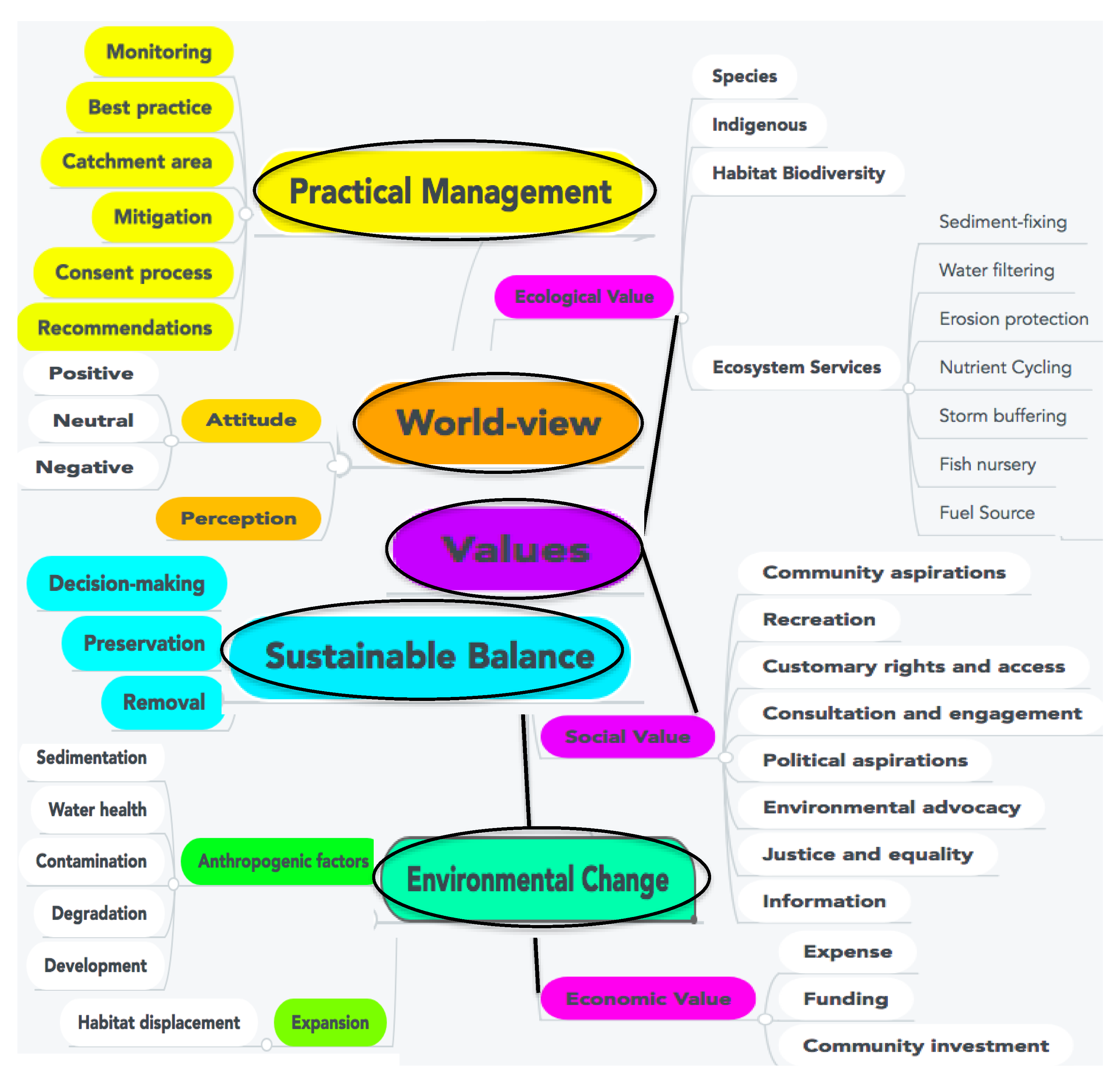
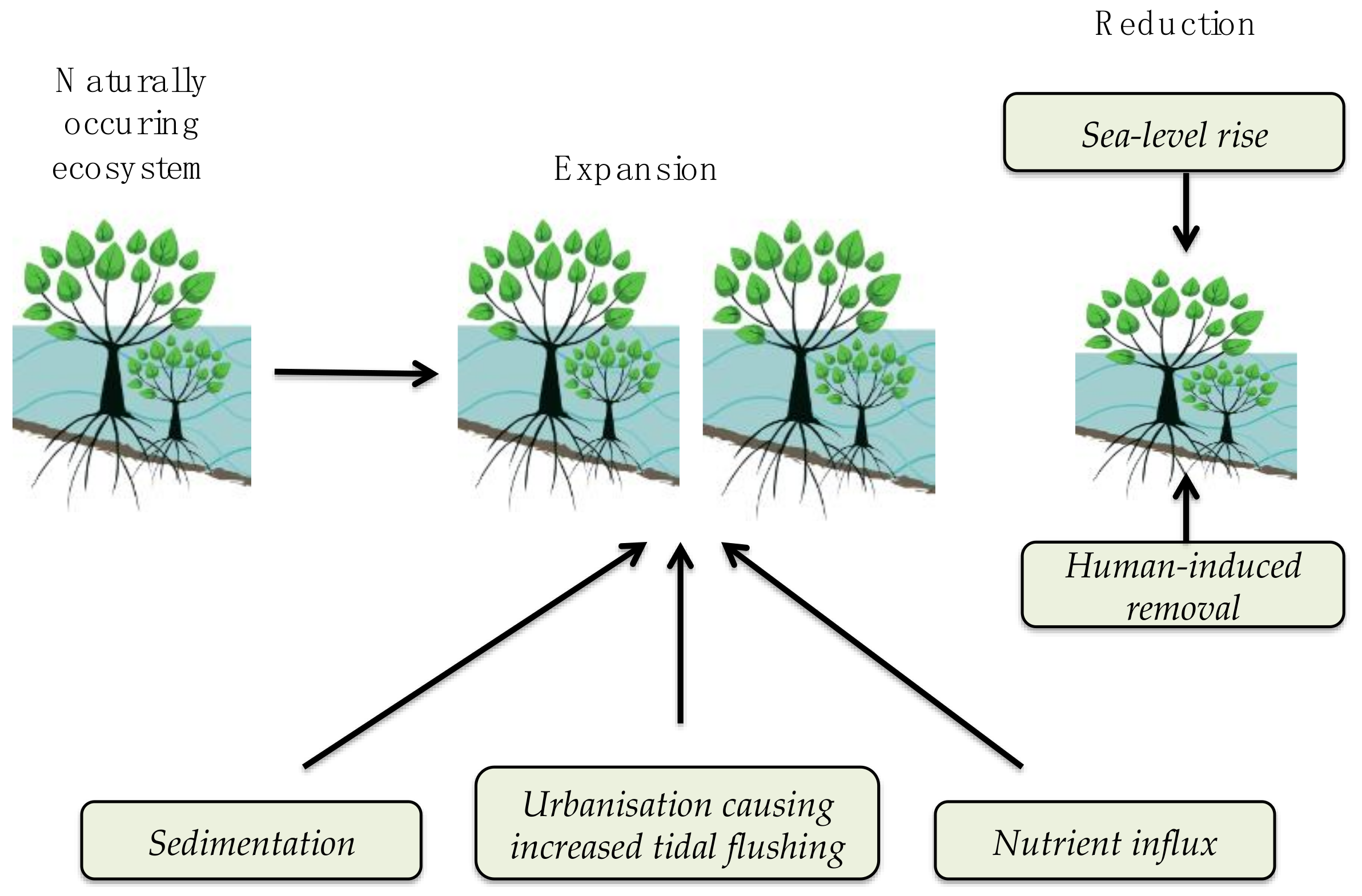
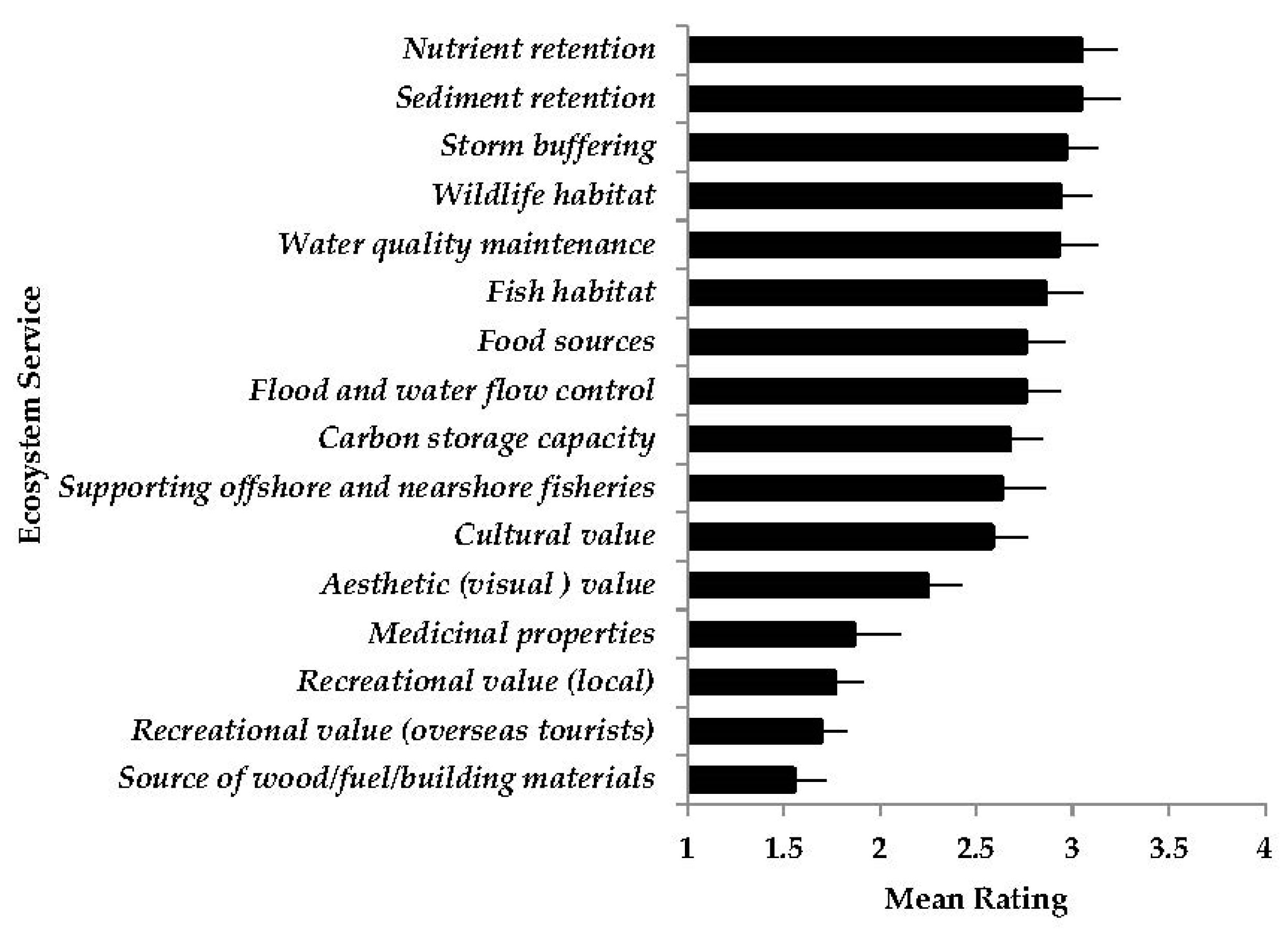
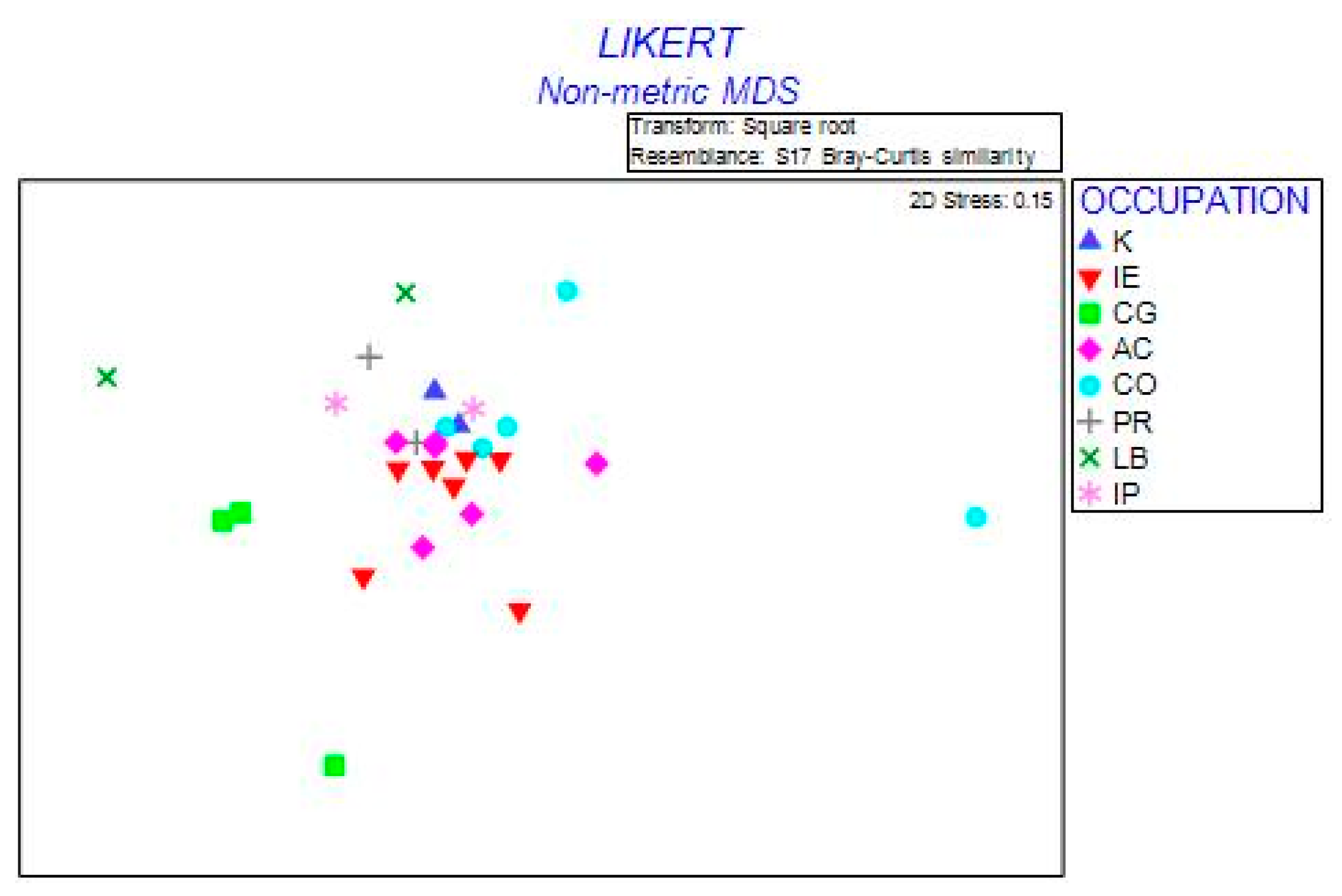
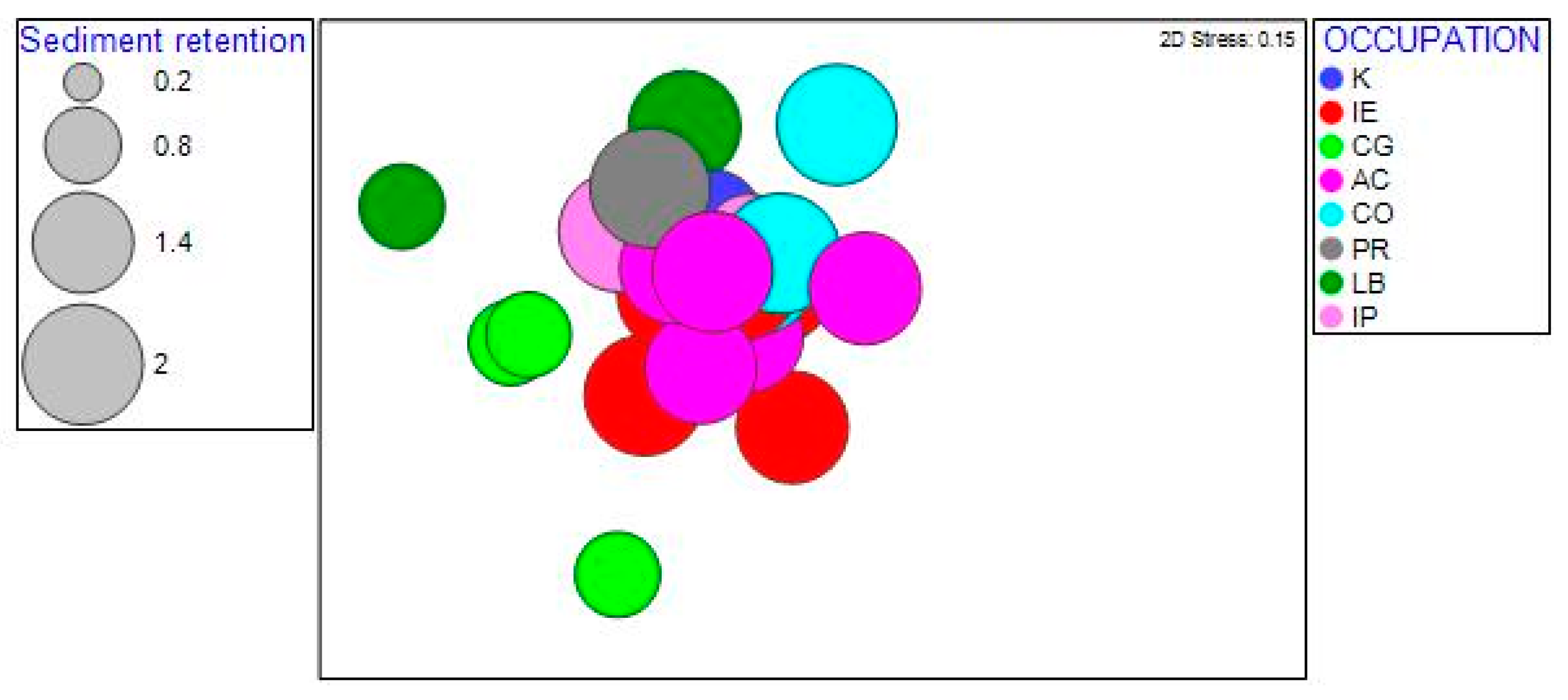
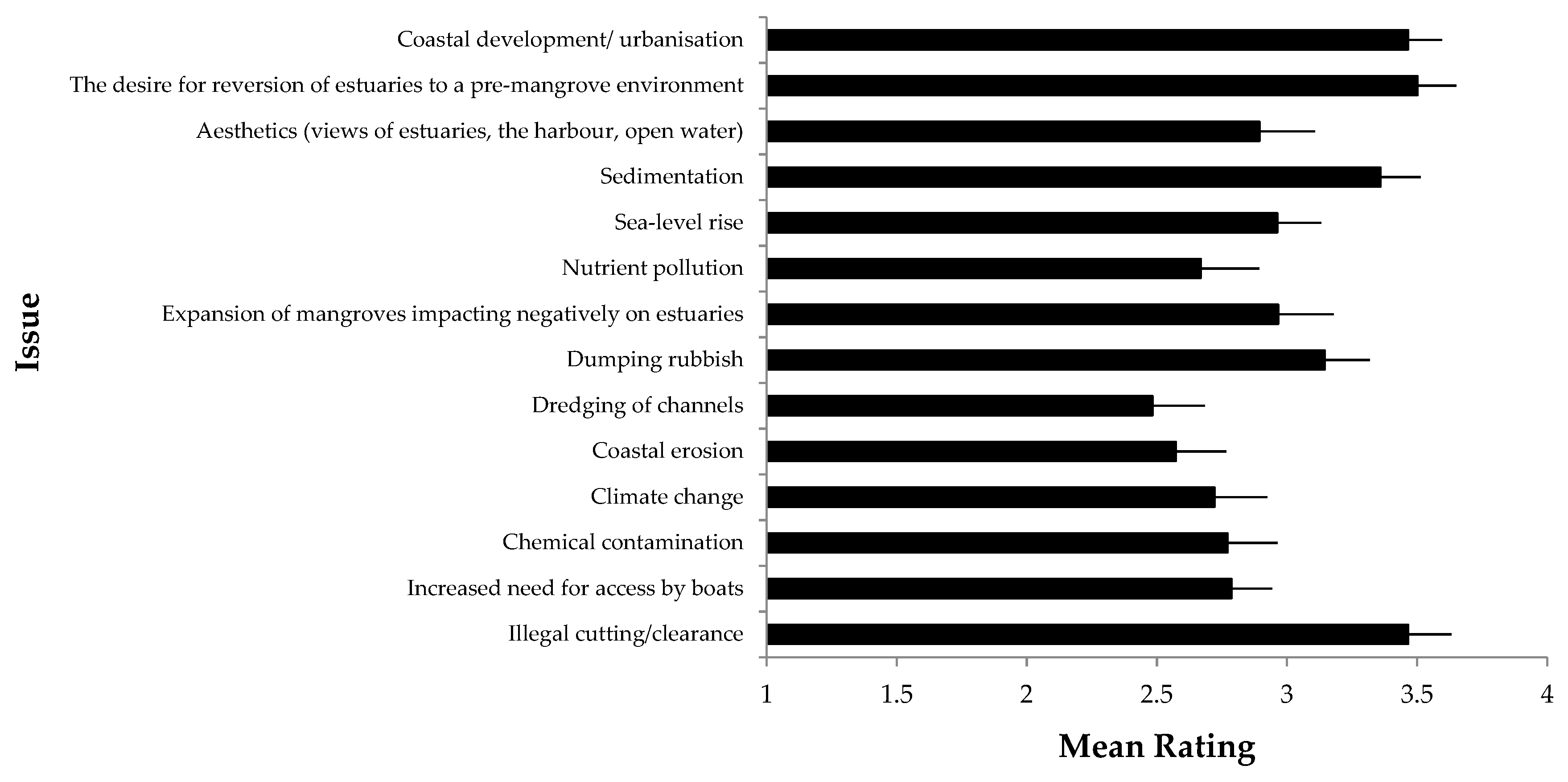
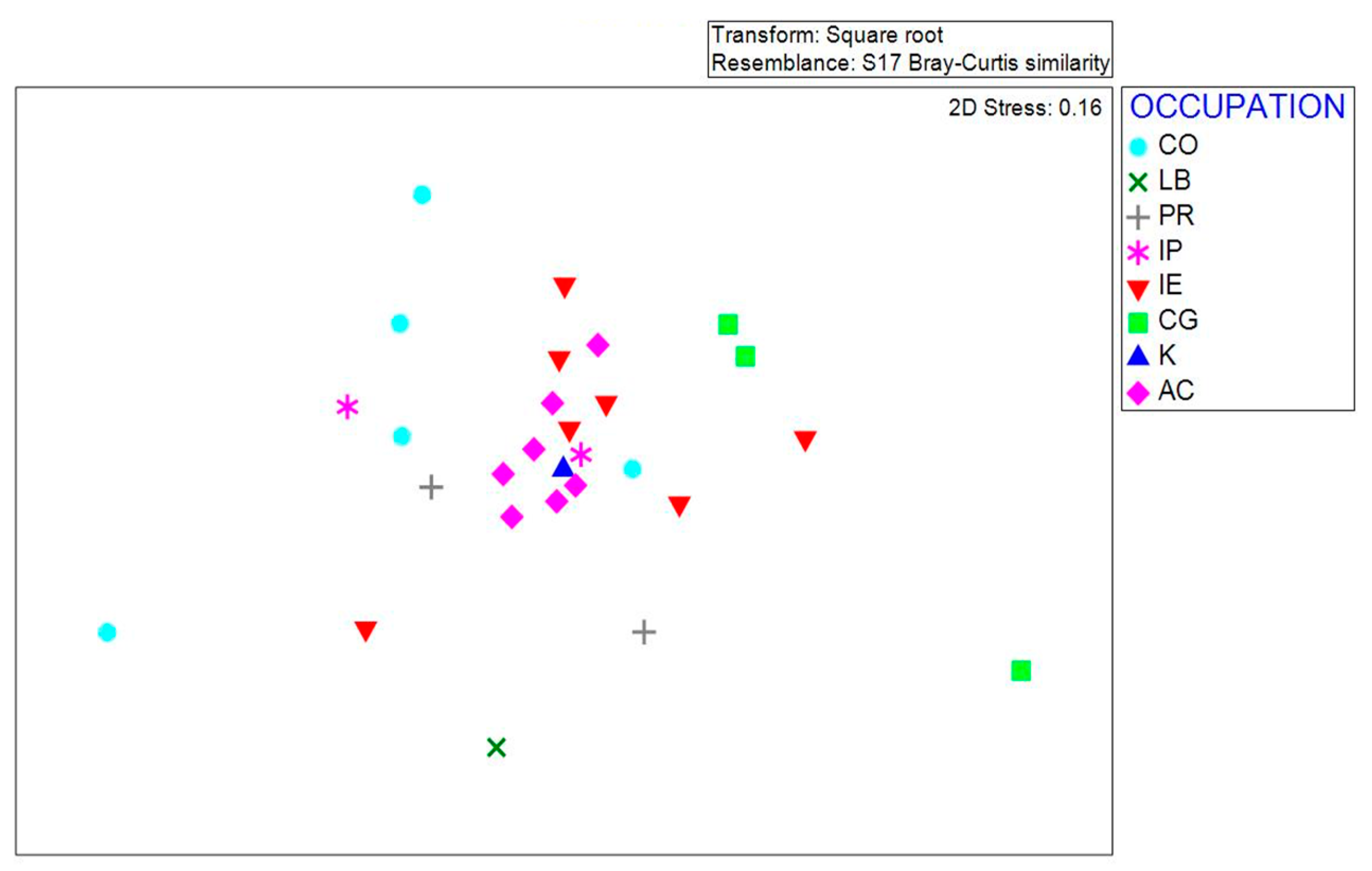
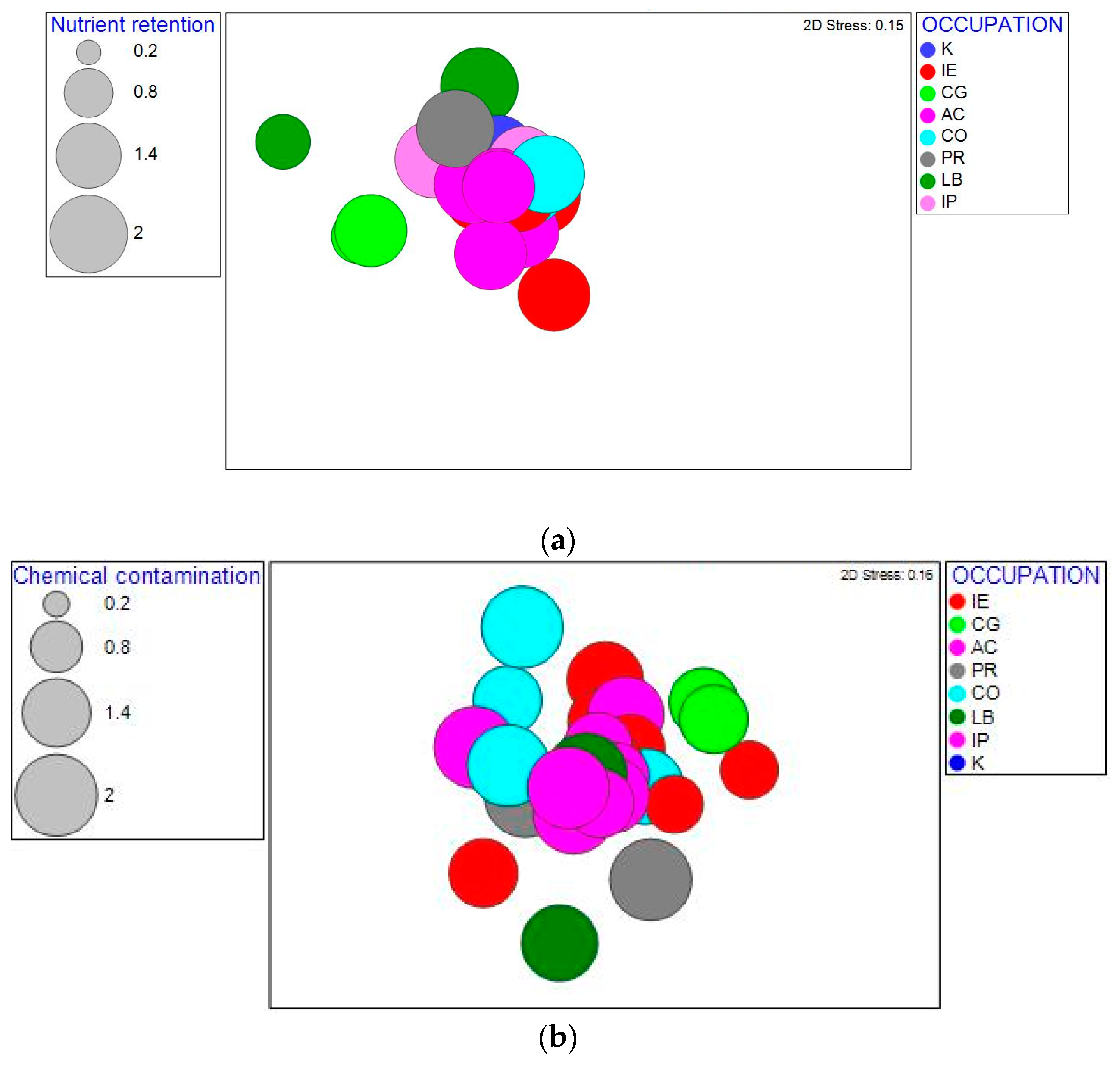
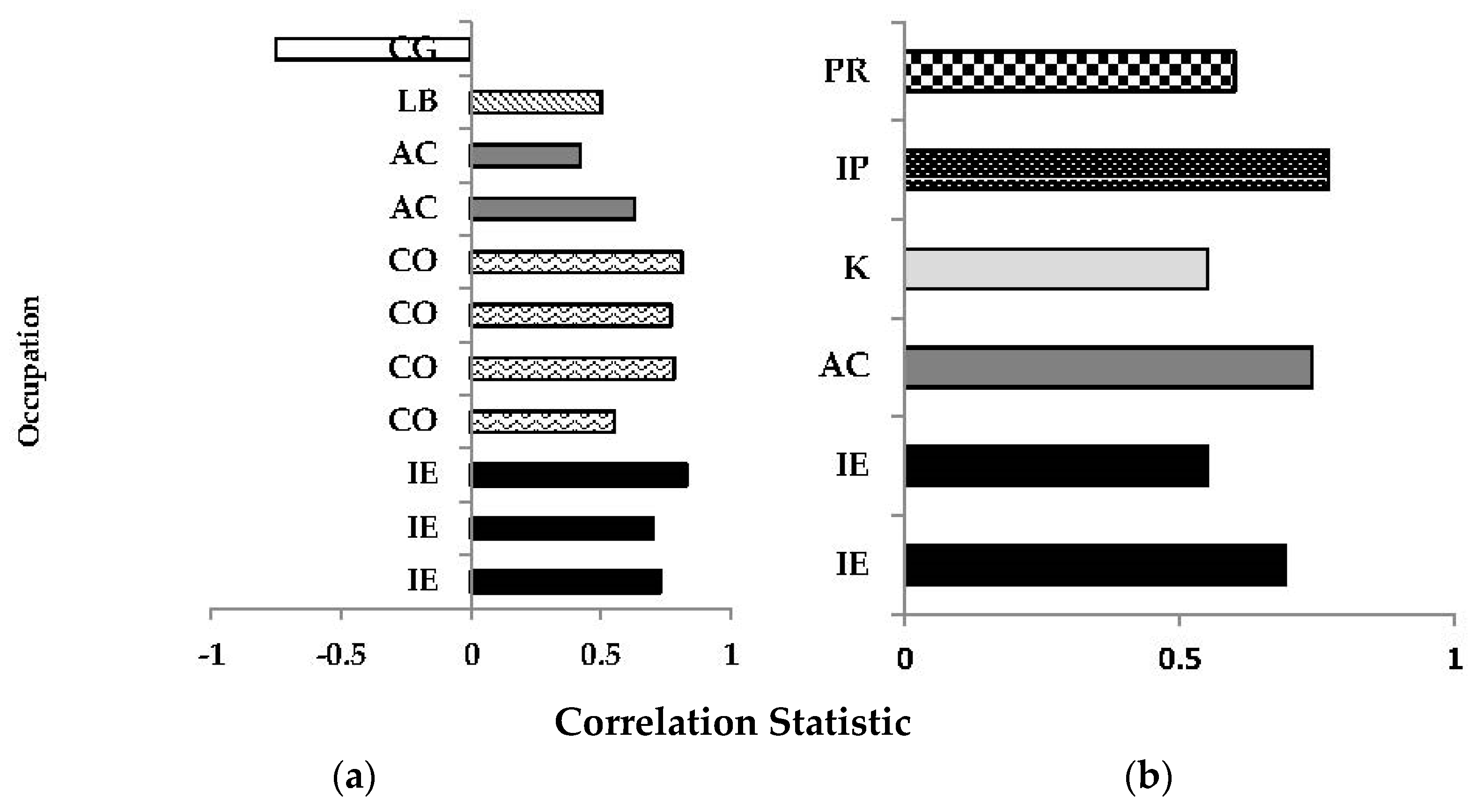
| (a) | |||||
| Rating | |||||
| Very Important | Important | Neither Important nor Unimportant | Not important | Don’t Know | |
| Mangrove Service | |||||
| Aesthetic (visual value) | |||||
| Carbon storage capacity | |||||
| Cultural value | |||||
| Fish habitat | |||||
| Flood and water flow control | |||||
| Food sources | |||||
| Medicinal properties | |||||
| Nutrient retention | |||||
| Recreational value (local) | |||||
| Recreational value (overseas tourists) | |||||
| Sediment retention | |||||
| Source of fuel/wood/building materials | |||||
| Storm buffering | |||||
| Supporting offshore and near-shore fisheries | |||||
| Water quality maintenance | |||||
| Wildlife habitat | |||||
| (b) | |||||
| Rating | |||||
| Big issue | Issue | Potential to be an issue | No issue | Don’t know | |
| Issues facing mangroves | |||||
| Illegal cutting/clearance | |||||
| Increased need for access by boats | |||||
| Chemical contamination | |||||
| Climate change (more severe droughts, floods and storms) | |||||
| Coastal erosion | |||||
| Dredging of channels | |||||
| Dumping rubbish | |||||
| Expansion of mangroves impacting negatively on estuaries | |||||
| Nutrient pollution | |||||
| Sea-level rise | |||||
| Sedimentation | |||||
| Aesthetics (views of estuaries, the harbour, open water) | |||||
| The desire for reversion of estuaries to a pre-mangrove environment | |||||
| Coastal development/urbanisation | |||||
| (a) |
| Mangrove expansion has impacted negatively on surrounding habitats |
| Mangroves encroach upon saltmarsh in some places which may alter their ecosystem function (saltmarsh) |
| Mangroves replace wading bird habitat (mudflat) in some areas |
| Mangroves stabilise mudflats |
| Maintaining saltmarsh-mangrove ecotones is important |
| Temperate mangroves have different attributes to tropical mangroves |
| Not enough research has been conducted regarding how removal of mangroves affects coastal and estuarine ecology |
| Mangroves should be preserved as much as possible based on their ability to sequester (long-term storage of) carbon |
| Mangroves are important for a variety of wildlife |
| Nothing of any ecological value exists in mangroves |
| Removing mangroves can result in the potential loss of ecological connectivity along shorelines for some species |
| Removal can result in the potential mobilisation of sediments and effects such as smothering of shellfish beds |
| Removal can result in better tidal flow and flushing of area within the inlets |
| Removal can create an improved connection between the land and the sea |
| We need baseline monitoring (on contaminated sediments and hydrology) to assess improvements to water quality, and information on contaminants |
| We need to address sedimentation and nutrient run-off from the land to slow the growth of mangroves |
| (b) |
| Removal of mangroves can provide improved recreation opportunities |
| Removal can provide opportunities for beach restoration |
| I would prefer to see a view of the water instead of mangroves |
| Mangrove removal is a reversible experiment (if we cut them down, they will grow back anyway) |
| We should look at improving the water quality of our harbour and monitoring this before we remove any more mangroves |
| Money is better spent elsewhere |
| If we decide to remove mangroves, we need to think carefully about the justification for this and select areas accordingly |
| Removing mangroves is long-term so we need to be able to afford it |
| Removing mangroves adds value to property |
| Mangroves have equal value to any other natural habitat |
| Everyone should have the right to remove mangroves |
| Beaches have been destroyed by mangrove expansion |
| Mangrove expansion is due to anthropogenic activities |
| If removed, this should be in a step-by-step process, monitoring should occur during and post removal to observe changes over time |
| Removing mangroves can enhance the amenity of an area to create a ‘strong sense of place’ for the community |
| People are the issue (with mangrove spread), but we need control over where they are to allow cultural activities to continue |
| We need to look at putting the environment first before we look after ourselves |
| Community Perception towards Mangrove | Participant | Quote |
|---|---|---|
| No community benefit | CG3 | “They are not perceived as having any redeeming community benefit at all. They are certainly highly detrimental to the health of any estuary”. |
| Not good due to expansion | AC5 | “The community’s perception is that mangroves are not good, that’s unfortunate, I don’t like that perception, but because of the rapid expansion of mangroves, people think they are everywhere”. |
| Visual improvement with removal | IE2 | “So I’m not convinced that clearing mangroves does anything apart from people having a visual improvement in their minds” |
| Negative impact on ecology | CG2 | “A magnificent tree and incredibly adapted tree with lovely smelling flowers but overall having a negative impact on the ecology in New Zealand”. |
| Ecology | Sentiment | Quote | Participant |
|---|---|---|---|
| Banded Rail | Mangroves as habitat | “… it’s probable or possible that the increase in mangrove habitat has actually formed a very good bastion for Banded Rail” “… so Banded Rail use mangroves as cover when they are foraging and they breed at the interface of mangroves and saltmarsh” | AC1 AC2 |
| Fish | Not important Temporary habitat | “They provide a different ecosystem service and we are not seeing them as important for fish nurseries” “There are some fish species that use the mangroves as a temporary nursery habitat, if that was the case, it’s only going to be for at a very small part of the tide” | AC2 CG1 |
| Erosion | Buffer against erosion | “in terms of erosion management to create a buffer along those coastlines”. “There had been mangroves along that shoreline. No doubt they would have prevented the erosion”. | AC3 CG3 |
| Sediment | Sediment-fixing | “… roles that I see are fixing sediment..” “I think they have a role in trapping sediment” | CO3 IE1 |
| Water quality | Improving water quality | “If we take all of those mangroves away, then we are taking the water and flushing it straight into the harbour with no improvement in water quality in between”. | CO5 |
| Occupation | t | p (PERM) | Unique Perms |
|---|---|---|---|
| IE, CG | 2.94 | 0.01 | 120 |
| IE, CO | 1.51 | 0.023 | 547 |
| CG, AC | 3.18 | 0.014 | 84 |
| CG, CO | 2.3 | 0.016 | 56 |
| AC, CO | 1.49 | 0.011 | 408 |
| IE, LB | 2.14 | 0.03 | 36 |
| AC, LB | 2.24 | 0.035 | 28 |
| Occupation | Overall Dissimilarity | Ecosystem Service | % | Cumulative% |
|---|---|---|---|---|
| CG, CO | 34.86 | Sediment retention (CO) Nutrient retention (CO) | 7.83 7.81 | 7.83 15.64 |
| AC, LB | 27.59 | Carbon storage capacity (AC) Water quality maintenance (AC) | 15.61 9.28 | 15.61 24.89 |
| CG, AC | 27.33 | Nutrient retention (AC) Cultural value (AC) | 8.20 8.13 | 8.20 16.33 |
| IE, LB | 26.90 | Carbon storage capacity (IE) Medicinal properties (LB) | 15.03 10.72 | 15.03 25.75 |
| IE, CG | 25.65 | Medicinal value (CG) Cultural value (IE) | 9.47 8.75 | 9.47 18.23 |
| AC, CO | 23.74 | Water quality (AC) Carbon storage capacity (AC) | 9.42 9.26 | 9.42 18.68 |
| IE, CO | 20.03 | Water quality (IE) Nutrient retention (IE) | 11.05 10.83 | 11.05 21.88 |
| Occupation | T | p |
|---|---|---|
| IE, CG | 1.90 | 0.019 |
| IE, AC | 1.76 | 0.005 |
| CG, AC | 2.58 | 0.011 |
| CG, CO | 2.15 | 0.019 |
| AC, CO | 1.44 | 0.044 |
| AC, LB | 1.79 | 0.036 |
| Occupation | Overall Dissimilarity | Issue | Percentage Contribution | Cumulative Percentage |
|---|---|---|---|---|
| CG, CO | 18.55 | Nutrient Pollution (CO) Chemical Contamination (CO) | 12.24 10.95 | 12.24 23.18 |
| IE, CG | 13.77 | Nutrient Pollution (IE) Sea-Level Rise (IE) | 13.32 12.03 | 13.32 25.36 |
| CG, AC | 13.68 | Nutrient Pollution (AC) Chemical Contamination (AC) | 15.28 13.21 | 15.28 28.49 |
| AC, CO | 11.42 | Expansion of mangroves (AC) Aesthetics (AC) | 13.18 10.83 | 13.52 24.00 |
| IE, AC | 9.77 | Climate Change (AC) Nutrient Pollution (AC) | 11.93 7.93 | 11.93 21.66 |
| LB, AC | 9.51 | Sea-level rise (AC) Climate Change (AC) | 24.33 22.31 | 24.33 46.64 |
| (a) | ||
| Number | Statement | Z-Scores |
| 9 | Mangroves are important for a variety of wildlife | 1.735 |
| 16 | We need to address sedimentation and nutrient run-off from the wider catchment... | 1.697 |
| 23 | If we decide to remove mangroves, we need to think carefully about the justification for this and select areas accordingly | 1.451 |
| 30 | If removed this should be a step-by-step process | 1.004 |
| 1 | Mangrove expansion has impacted negatively on surrounding habitats | −1.134 |
| 19 | I would prefer to see a view of the water instead of mangroves | −1.447 |
| 27 | Everyone should have the right to remove mangroves | −2.258 |
| 10 | Nothing of any ecological value exists in mangroves | −2.296 |
| (b) | ||
| Statement Number | Statement | Z-Scores |
| 16 | We need to address sedimentation and nutrient run-off from the land to slow the growth of mangroves | 1.774 |
| 15 | We need baseline monitoring (on contaminated sediments and hydrology) to assess improvements to water quality, and information on contaminants | 1.717 |
| 23 | If we decide to remove mangroves, we need to think carefully about the justification for this and select areas accordingly | 1.649 |
| 29 | Mangrove expansion is due to anthropogenic activities | 1.231 |
| 3 | Mangroves replace wading bird habitat (mudflat) in some areas | 1.110 |
| 25 | Removing mangroves adds value to property | −1.472 |
| 8 | Mangroves should be preserved as much as possible based on their ability to sequester (long-term storage of) carbon | −1.326 |
| 10 | Nothing of any ecological value exists in mangroves | −1.843 |
| 27 | Everyone should have the right to remove mangroves | −2.483 |
| Method | Analyses | Evaluation |
|---|---|---|
| Semi-structured interviews | Queries and Classifications matrix coding query (CG and CO) with all nodes | Greater perceived value and positive attitude towards mangroves by CO, highlighted in themes of world-view, sustainable balance, environmental change, values and practical management |
| Scale rating of ecosystem services and issues | PERMANOVA with “Occupation” as fixed factor, Bray–Curtis similarity matrix | Significant differences between groups p < 0.05. Greatest dissimilarity of all groups for both ecosystem services and issues. Driven by ranking of sediment and nutrient retention as services and nutrient pollution and chemical contamination as issues facing mangroves, CO ranking these higher than CG. |
| Q-Sort | Sorting of 33 social and ecological statements | Loading of all CO’s onto “pro-protectionist” attitude, only CG in sort loading negatively onto this factor. |
© 2019 by the authors. Licensee MDPI, Basel, Switzerland. This article is an open access article distributed under the terms and conditions of the Creative Commons Attribution (CC BY) license (http://creativecommons.org/licenses/by/4.0/).
Share and Cite
Dencer-Brown, A.M.; Alfaro, A.C.; Milne, S. Muddied Waters: Perceptions and Attitudes towards Mangroves and Their Removal in New Zealand. Sustainability 2019, 11, 2631. https://doi.org/10.3390/su11092631
Dencer-Brown AM, Alfaro AC, Milne S. Muddied Waters: Perceptions and Attitudes towards Mangroves and Their Removal in New Zealand. Sustainability. 2019; 11(9):2631. https://doi.org/10.3390/su11092631
Chicago/Turabian StyleDencer-Brown, Amrit Melissa, Andrea C. Alfaro, and Simon Milne. 2019. "Muddied Waters: Perceptions and Attitudes towards Mangroves and Their Removal in New Zealand" Sustainability 11, no. 9: 2631. https://doi.org/10.3390/su11092631
APA StyleDencer-Brown, A. M., Alfaro, A. C., & Milne, S. (2019). Muddied Waters: Perceptions and Attitudes towards Mangroves and Their Removal in New Zealand. Sustainability, 11(9), 2631. https://doi.org/10.3390/su11092631




